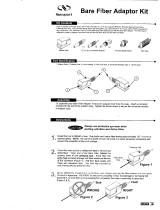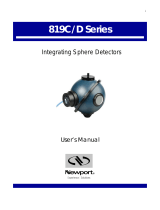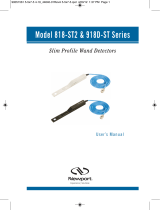Page is loading ...

Fiber Optic Prism Switch
USER’S
MANUAL

ii Preface
Warranty
Newport Corporation warrants this product to be free
from defects in material and workmanship for a period
of one year from the date of shipment. If found to be
defective during the warranty period, the product will
either be repaired or replaced at Newport's option.
To exercise this warranty, write or call your local
Newport office or representative, or contact Newport
headquarters in Irvine, California. You will be given
prompt assistance and return instructions. Send the
instrument, transportation prepaid, to the indicated
service facility. Repairs will be made and the
instrument returned transportation prepaid. Repaired
products are warranted for the balance of the original
warranty period or at least 90 days.
Limitation of Warranty
This warranty does not apply to defects resulting from
modification or misuse of any product or part. This
warranty also does not apply to fuses, batteries, or
damage from battery leakage.
This warranty is in lieu of all warranties, expressed or
implied, including any implied warranty of
merchantability or fitness for a particular use. Newport
Corporation shall not be liable for any indirect, special,
or consequential damages.
First Printing September 1999
Copyright 1999 by Newport Corporation, Irvine, CA.
All rights reserved. No part of this manual may be
reproduced or copied without the prior written
approval of Newport Corporation.

Preface iii
This manual has been provided for information only
and product specifications are subject to change
without notice. Any change will be reflected in future
printings.
1999 Newport Corporation
1791 Deere Ave.
Irvine, CA 92606
(949) 863-3144
P/N 28989-01, Rev. A (IN-06999) (9/99)

iv Preface
Table of Contents
Warranty...............................................................ii
Limitation of Warranty.........................................ii
Section 1 - Introduction......................................1-1
1.1 Scope ..........................................................1-1
1.2 Safety Considerations.................................1-1
1.3 Convention and Symbols............................1-2
1.3.1 Safety and General Symbols/
Definitions ...................................1-2
1.3.2 Terminology.................................1-2
1.4 Product Overview.......................................1-4
Section 2 – Switch Control.................................2-1
2.1 Non-Latching Two-Pin Control .................2-2
Section 3 - Specifications....................................3-1
3.1 Housing Dimensions ..................................3-2
Section 4 – Handling Fiber Optic Components
and Cables...........................................................4-1
4.1 Handling Fiber Optic Cables......................4-1
4.2 Storing Optical Connectors ........................4-2
4.3 Cleaning Optical Connectors......................4-2
4.4 Mating Optical Connectors.........................4-3
Section 5 – Factory Service................................5-1

Preface v
List of Figures
Figure 1.1 – Fiber Optic Prism Switch...................................................................1-4
Figure 2.1 – Two-Pin Control Electrical Schematic...............................................2-2
Figure 3.1 – Housing Dimensions for 1x2 Prism Switch........................................3-2
Figure 3.2 – Housing Dimensions for 2x2 Prism Switch........................................3-3
Figure 4.1 – Fiber Optic Component......................................................................4-2
List of Tables
Table 2.1 – Switch Control......................................................................................2-1
Table 2.2 – Switch Control......................................................................................2-2
Table 3.1 – Optical Specifications...........................................................................3-1
Table 3.2 – Electrical Specifications.......................................................................3-1
Table 3.3 – Environmental Specifications...............................................................3-2
Table 5.1 – Technical Customer Support Contacts.................................................5-1

vi Preface

Section 1 - Introduction 1- 1
Section 1
Introduction
1.1 Scope
This manual provides descriptions and operating
information for the Fiber Optic Prism Switch.
Section 1, Introduction includes safety
considerations, conventions and definitions, and a
product overview.
Section 2, Switch Control includes specific
information, non-latching two-pin control description
and schematic, and related tables.
Section 3, Specifications defines product optical,
electrical, environmental specifications, and housing
dimensions for the 1x2 and 2x2 Prism Switch.
Section 4, Handling Fiber Optic Components and
Cables for the product are defined, and also storing,
cleaning, and mating of optical connectors.
Section 5, Factory Service information and a service
form are included.
1.2 Safety Considerations
The following general safety precautions must be
observed during all phases of operation of the product.
Failure to comply with these precautions or with
specific warnings elsewhere in this manual violates
safety standards of design, manufacture, and intended
use of the product.

1- 2 Section 1 - Introduction
To protect the product from damage and avoid
hazardous situations, follow these recommendations:
• Do not make modifications to the product.
• Return the product to Newport Corporation for
service and repair.
• Keep liquids away from the product.
• Do not expose the product to excessive moisture
(>90% humidity).
1.3 Conventions and Symbols
This section provides a list of symbols and their
definitions, and commonly used terms found in the
manual.
1.3.1 Safety and General Symbols/Definitions
The following is a definition of safety and general
symbol used in this manual.
____________________________________________
CAUTION
____________________________________________
1.3.2 Terminology
The following is a brief description of the terms
specific to the Fiber Optic Prism Switch.
Bandwidth The range of operating
wavelengths over which
performance parameters are
specified.
Calls attention to a procedure,
practice, or condition which, if
not correctly adhered to, could
result in damage to the product
(e.g., refer to accompanying
documents).

Section 1 - Introduction 1- 3
Directivity The ratio of the power returned
to any other input port to the
launched power, expressed in
dB.
Excess Loss The ratio of the total power at
all output ports to the launched
power, expressed in dB.
Isolation The ratio of the power at an
output port in the transmitted
wavelength band to that in the
extinguished wavelength band.
Non-Latching These style of switches require
no power to maintain one
position and a constant +5 VDC
drive current to maintain the
other position.
Polarization-Dependent
Loss (PDL) The maximum (peak to peak)
variation in insertion loss as the
input polarization varies,
expressed in dB.
Port Configuration Number of input ports x number
of output ports (e.g., 2x2).
Return Loss The ratio of the power returned
to the input port to the launched
power expressed in dB.
Uniformity The difference between
maximum and minimum
insertion losses.

1- 4 Section 1 - Introduction
1.4 Product Overview
Newport's 1x2 and 2x2 Prism Switch provides channel
selection from one or two input fibers to two output
fibers, using a moving prism between fixed
collimators.
Newport's 1x2 and 2x2 switches are actuated
electrically and require +5 VDC to switch position.
The switches are housed in a compact,
environmentally stable package designed for mounting
on printed circuit boards or within a module.
Key Features:
• Single and multimode fiber optic switch design
• 1x2 and 2x2 configurations are available
• Low insertion loss and low back reflection
• High durability – greater than 10 million cycles.
Figure 1.1: Fiber Optic Prism Switch

Section 2 – Switch Control 2-1
Section 2
Switch Control
The four-pin electrical interface is used to control and
monitor switch position. The electrical connector is
Molex P/N 22-23-2041, and mates with Molex P/N 22-
01-3047 or equivalent.
Pin 4 is the position sensor output. The output
alternates between normal open contact and normal
close contact (low or high signal) depending on the
switch position. The position sensor is powered with
+5 VDC on pin 3. Pins 1, 2 and 3 are used for control
and power supply. Pin behavior depends upon the
electrical configuration of the user's switch. The
electrical configuration is described in the following
section, and summarized in Table 2.1, and Table 2.2.
1x2 Switch
Output 2
1x2 Switch
Output 1
Position Sensor Position Sensor
Actuation Style
Pin 3 Pin 4 Pin 3 Pin 4
Non-Latching
2-Pin
+5 VDC Low* +5 VDC High**
* Normal open contact
* Normal close contact
Table 2.1: Switch Control

2-2 Section 2 – Switch Control
Input 1 Output 1
Input 2 Output 2
Input 1 Output 1
Input 2 Output 2
Switch
Control
Position
Sensor
Switch
Control
Position
Sensor
Actuation Style
Pin 1 Pin 2 Pin 3 Pin 4 Pin 1 Pin 2 Pin 3 Pin 4
Non-Latching
2-Pin
GND GND +5
VDC
Low
*
GND +5
VDC
+5
VDC
High
**
* Normal open contact
** Normal close contact
Table 2.2: Switch Control
2.1 Non-Latching Two-Pin Control
Switches configured for non-latching two-pin control
require no power to maintain one position and a
constant +5 VDC across pins 1 and 2 to maintain the
other position (See Electrical Schematic in Figure
2.1).
Figure 2.1: Two-Pin Control Electrical Schematic
Pin 4 (Position Sensor)
Pin 3 (Sensor Power)
Pin 2 (Control)
Pin 1 (Control)

Section 3 - Specifications 3-1
Section 3
Specifications
Parameter Minimum Typical Maximum Units
Wavelength range 1290 1570 Nm
Insertion loss - 0.6 1.1 DB
Back-reflection (single-mode) - - -55 DB
Back-reflection (multimode) - - -20 DB
Switching time - 10 15 Ms
Cross-talk - - -80 DB
Durability 10 Megacycles
Repeatability ** - - ± 0.01 DB
PDL *** 0.05 DB
* All specifications referenced without connectors
** Repeatability for 100 cycles at constant temperature
*** Single-mode only. Measured at 1550 nm
Table 3.1: Optical Specifications
_____________________________________________________________________
Parameter Actuation
Style
Minimum Maximum Units
Switching voltage - 4.5 6.0 VDC
Switching current Non-latching
2-Pin
36 48 mA
Coil resistance Non-latching
2-Pin
112.5 137.5 Ohm
Sensor input voltage - 4.3 6.0 VDC
Sensor input current - 90 120 mA
Table 3.2: Electrical Specifications
_____________________________________________________________________

3-2 Section 3 - Specifications
Parameter Minimum Typical Maximum Units
Operating temperature -20 - 75 °C
Storage temperature -40 - 85 °C
Humidity 60°C / 90%
RH / 14
days
60°C / 90%
RH / 14
days
60°C / 90%
RH / 14
days
-
Table 3.3: Environmental Specifications
3.1 Housing Dimensions
The following illustrations, Figure 3.1 and Figure 3.2
show the Housing Dimensions for 1x2 and 2x2 Prism
Switch.
Figure 3.1: Housing Dimensions for 1x2 Prism Switch
74.5
67.0
20.0
5.9
9.8
3.3
Output 1
Output 2
Common
23.0
6.9
12.0 40.0
2.2
Mounting Through
Hole 2 Places
16.0
6.0
2.0
2 Places
6.0
2 Places
Pin 1
6.4
2.54
2.8
5.9
10.1
22.1

Section 3 - Specifications 3-3
Figure 3.2: Housing Dimensions for 2x2 Prism Switch
10.1
25.6
7.2
2.54
TYP
Pin 1
6.4
4.0
Aux. Blind Mounting Hole
M3X0.5 3.00 DP
2 Places
6.5
2 Places
4.0
6.0
16.0
Output 2
Output 1
3.3
7.8
11.4
20.0
40.0
61.0
26.0
3.3
Input 1
Input 2
32.0
8.4
ÿ 3.2 Through
Mounting Hole
2 Places
74.5
67.0
8.5
11.0
Unit
s: mm

3-4 Section 3 - Specifications

Section 4 – Handling Fiber Optic Components and Cables 4-1
Section 4
Handling Fiberoptic
Components and Cables
4.1 Handling Fiber Optic Cables
The user's switch may come with fiber pigtail outputs.
Treat cables with care to avoid cable damage and
minimize optical loss. The minimum bend radius for
most optical cables is 35mm. Never bend an optical
cable more sharply than this specification. Optical
performance will degrade and the cable may break.
• Avoid bending the optical cable near a cable strain
relief boot. Bending an optical cable near a strain
relief boot is one of the easiest ways to
permanently damage the optical fiber.
• Avoid bending the optical cable over a sharp edge.
• Avoid using cable tie wraps to hold optical cable.
Tie wraps when tightened can create micro-bends
or break an optical cable. Micro-bends can cause a
dramatic reduction in optical performance.
• Do not pull on the bare fiber as this can break the
fiber inside the component.
• Avoid using soldering irons near optical cable.
Accidental damage can easily occur when a
soldering iron is used near an optical cable. In
addition, solder splatter can contaminate and
permanently damage optical fiber connectors.

4-2 Section 4 – Handling Fiber Optic Components and Cables
• In order to obtain the most stable, repeatable
optical performance, immobilize optical cables
using wide pieces of tape or some form of
mechanical cushion after the optical cables have
been connected.
Figure 4.1: Fiber Optic Component
4.2 Storing Optical Connectors
All switches are shipped with dust caps in place
covering all optical connectors. Optical connectors
should remain covered at all times when the instrument
is not in use.
4.3 Cleaning Optical Connectors
Clean any exposed connector using a cleaning kit
supplied by the connector manufacturer or high-grade
isopropyl alcohol and a cotton swab.

Section 4 – Handling Fiber Optic Components and Cables 4-3
To clean with alcohol and a swab, dab the tip of a
cotton swab in alcohol and then shake off any excess
alcohol. The tip should be moist, not dripping wet.
Stroke the swab tip gently across the surface of the
connector and around the connector ferrule. Either
allow the connector a minute to dry, or blow dry the
connector using compressed air. Be careful when using
compressed air because improper use may deposit a
spray residue.
4.4 Mating Optical Connectors
• Clean both connectors prior to mating. Any small
particles trapped during the mating process can
permanently damage the connector.
• Insert the appropriate connector ferrule into the
adapter smoothly. Do not allow the fiber tip to
contact any surface. If the tip accidentally contacts
a surface before mating, stop. Re-clean the
connector and try again.
• Tighten the connector until it is finger tight, or to
the torque specified by the connector
manufacturer. Do not over-tighten the connector
as this can lead to optical loss and connector
damage.
• Check the optical insertion loss. If the loss is
unacceptable, remove the connector, re-clean both
ends of the mate, and reconnect. The user may
have to repeat this process several times before a
low-loss connection is made.
• After the user makes the connection, they should
monitor the stability of the optical throughput for
a few minutes.

4-4 Section 4 – Handling Fiber Optic Components and Cables
Optical power trending (slowly increasing or
decreasing) is caused by the slow evaporation of
alcohol trapped in the connection. Continue to
monitor optical power until it stabilizes. If the loss
is unacceptable, re-clean the connector and start
again.
/










